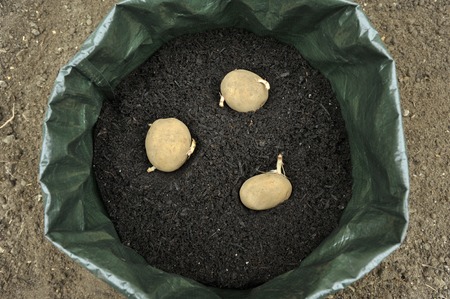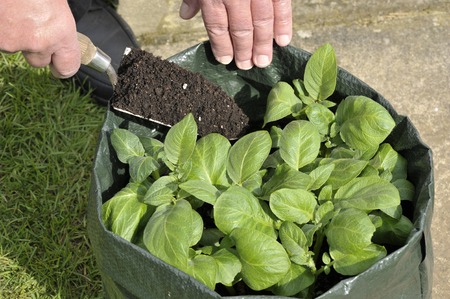Few things are tastier and more satisfying than your own, home grown spuds. If you have no vegetable plot or a
lack of space, why not grow some potatoes in bags? They will also be far less prone to the pests and diseases associated with growing them in the ground.
Growing bags can be purchased from many of the online catalogues, some of which come as a set with the seed potatoes included. If you do not buy a set then the tubers can be bought separately from the same sources from January onwards. Chitting the potatoes (see earlier article) will get the tubers off to an earlier start and produce a heavier yield.
The number of seed potatoes required for each bag will depend on the volume of the bag. A forty litre bag will need three to five tubers. Smaller bags need less. If you wish to harvest over a longer period, stagger planting each bag by four to six weeks. The bags can be planted as soon as the worst frosts are over in your area of the U.K, from March to May. If there is a frost forecast you can cover them with fleece to protect them. All potatoes can be grown in bags. However first and second earlies are often ready for harvest before the risk of blight is increased. The bags should be situated in a bright, frost free area.

Below are some suggested planting and harvesting times for different types of potatoes:-
First earlies: Plant: March-April Harvest: May-June
Second earlies: Plant: March-May Harvest: July-August
Maincrops: Plant: March-April Harvest: July-October
Salad varieties: Plant: March-May Harvest: July-September
First earlies can also be planted from late February but they are likely to require the protection of a glasshouse or polytunnel if planted so early. If in doubt it is best to leave it until March.
Method one
Pour around four centimetres or one and a half inches of quality multipurpose compost into the bottom of the bag. Place your seed potatoes on top of the layer of compost with the shoots facing upwards. Cover the tubers with six centimetres or two and a half inches of compost. The compost should be kept moist but not saturated throughout the growing season. Feed weekly with a high potash soluble plant food. Beware of slugs and treat accordingly.
When the shoots reach seven centimetres or three inches tall, add more compost until the shoots are covered. The shoots will continue to grow. Keep covering them as they grow until the compost is just below the top of the bag. This method is called earthing up.

Method two
Recent trials by experts such as Thompson and Morgan show earthing up is not necessary and it is possible to grow potatoes in bags by an easier method. You can simply fill the bag with compost to around two and a half centimetres or one inch below the top of the bag. Plunge the potatoes, shoots upwards, into the compost about twelve centimetres or five inches deep, and cover with the compost.
You may wish to experiment with both methods and make your own decisions on which produces the best crop.

Harvesting
With both methods, the shoots will grow out of the top of the compost and come into flower. After the plants have finished flowering, your potatoes will be ready to harvest. It is often a good idea to leave maincrop varieties in the bag for a couple more weeks until the foliage withers. The longer you leave the tubers growing, the larger the resulting potatoes will be. You can remove a few potatoes from the bag at a time or tip out the whole bag to harvest the entire crop.
Potatoes should be stored in a cool, dark, frost free place where air can circulate. They should be washed before use.
Second crop potatoes
It is possible to grow a later crop of potatoes to be enjoyed in the autumn and winter. Many people like to grow this second crop so they can be eaten on Christmas day. You will have to buy seed potatoes that have been kept in cold storage throughout the summer. Many of the online catalogues will offer these. They are available from July and do not need chitting. Plant them in August and allow eleven to twelve weeks before harvesting. If the weather becomes frosty the bags will have to be moved into a frost free greenhouse or polytunnel. When the tubers are mature they can be stored in the growing bags in a frost free shed or greenhouse and saved for the festive period.
Mark Snelling
All images copyright Gardenforpleasure.co.uk
To view the selection of seed potatoes at Thompson & Morgan click here

